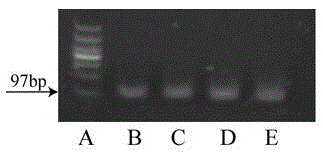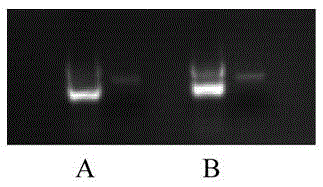Method for establishing CYP2C11 gene knockout rat model
A CYP2C11, gene knockout technology, applied in the field of transgenic technology, can solve the problems of poor specificity and high off-target rate, and achieve an effect that is beneficial to early toxicity
- Summary
- Abstract
- Description
- Claims
- Application Information
AI Technical Summary
Problems solved by technology
Method used
Image
Examples
Embodiment 1
[0033] 1. Use the GeneKnock-OutwithCas9 software (provided by Nanjing Yuqi Biotechnology Co., Ltd.) to determine the selection of two specific sgRNA target sequences in the target site exon6 of the CYP2C11 gene (GeneID: 29277). The two target sequences are sgRNA1: GCTACTGTAACTGACATGTT; sgRNA2: TCAAGGGTAAACTCAGACTG
[0034] 2. Construction of Cas9 plasmid expressing sgRNA
[0035] (1) Synthesize 2 pairs of specific sgRNA target sequence primers in Nanjing GenScript Biotechnology Co., Ltd.:
[0036] RatCYP2C11_c9_1-O1: caccGCTACTGTAACTGACATGTT
[0037] and Rat_CYP2C11_c9_1-O2: aaacAACATGTCAGTTACAGTAGC;
[0038] Rat_CYP2C11_c9_2-O1: caccTCAAGGGTAAACTCAGACTG
[0039] and Rat_CYP2C11_c9_2-O2: aaacCAGTCTGAGTTTACCCTTGA
[0040] (2) Take 5 μL of upstream and downstream primers (100 μM) of sgRNA1 and mix them; at the same time, mix 5 μL of upstream and downstream primers (100 μM) of sgRNA2, put them in boiling water, take them out for 20 minutes (94°C~55°C), anneal into double stra...
Embodiment 2
[0076] 1. Breeding of CYP2C11 knockout rats:
[0077] One F1 generation male CYP2C11 knockout rat heterozygous and two SD female mice (provided by Animal Experiment Center of Jiangsu University) were used for breeding. Three months later, 17 offspring were obtained, and the offspring (F2 generation) were identified. The identification results showed that 11 offspring male rats were heterozygous and 6 female rats were heterozygous. The resulting male heterozygotes (CYP2C11 + / - ) with female heterozygotes (CYP2C11 + / - ) as the parents with 1:2 pairing to expand the number of homozygous populations.
[0078] 2. CYP2C11 Genomic DNA Extraction and Identification
[0079] When the offspring rats were 7-14 days old, they were marked with the toe clipping method, the cut tissues were collected, lysate and proteinase K (sigma) were added, and mixed well. overnight at 55°C in a thermostatic shaking box. Add phenol: chloroform: isoamyl alcohol (volume ratio 25:24:1), and mix well. ...
PUM
 Login to View More
Login to View More Abstract
Description
Claims
Application Information
 Login to View More
Login to View More - R&D
- Intellectual Property
- Life Sciences
- Materials
- Tech Scout
- Unparalleled Data Quality
- Higher Quality Content
- 60% Fewer Hallucinations
Browse by: Latest US Patents, China's latest patents, Technical Efficacy Thesaurus, Application Domain, Technology Topic, Popular Technical Reports.
© 2025 PatSnap. All rights reserved.Legal|Privacy policy|Modern Slavery Act Transparency Statement|Sitemap|About US| Contact US: help@patsnap.com



